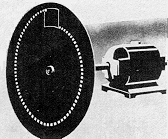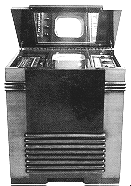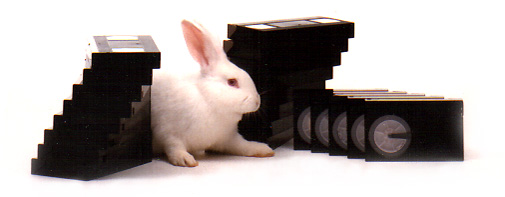
 OLLAPSING BOTH TIME AND SPACE, television extends our senses of sight and sound beyond their natural limits. It can transport us anywhere in the world. By bringing the world into our homes, it heightens our awareness and changes our perceptions of life itself. Now just over 50 years of age, television seems to have brought man full-circle, reinstating the spoken word to preeminence over the written one. OLLAPSING BOTH TIME AND SPACE, television extends our senses of sight and sound beyond their natural limits. It can transport us anywhere in the world. By bringing the world into our homes, it heightens our awareness and changes our perceptions of life itself. Now just over 50 years of age, television seems to have brought man full-circle, reinstating the spoken word to preeminence over the written one.
There was no one single invention call "television." Instead, a series of at least at a dozen different technologies would eventually converge in the 20th Century, to create what we now call television.
The key obstacle was always the fundamental difference between the way we hear and the way we see. We perceive only one sound sensation or sound wave at a time. There may be many sound waves, but we hear them just one at a time. However,  when we see something, we see millions of light sensations all at the same time. We don't see one part of a scene, go on to the next and so forth, until we can put them all together to from the complete picture of what we are looking at. We see it all and we see it instantly. when we see something, we see millions of light sensations all at the same time. We don't see one part of a scene, go on to the next and so forth, until we can put them all together to from the complete picture of what we are looking at. We see it all and we see it instantly.
HOW THE EYE WORKS
It is fitting then that the human eye offered the first clues as to how this new technology would take place. The inner lining of the eye or the retina, contains millions of receptors that break the scene, to which the eye is focused on, up into points of light — like a mosaic. These points of light are then transformed into electrical impulses. Hundreds of thousands of nerve fibers similar to electrical circuits — carry these impulses to the brain simultaneously, so that the whole scene is perceived at one time. Electronically, it is only feasible to use one circuit at a time. Therefore, a way had to be developed to transmit the pieces of the scene one piece at a time, reproduce them individually, and then reassemble them in their correct positions to duplicate the original scene. In addition, this had to be done without the human eye detecting how you were doing it.
DOING WHAT THE EYE DOES
The first true television mechanism to accomplish this came in 1884. In that year, a German engineer, Paul Nipkow, patented the Nipkow disk.  It was a simple mechanical device that used a spinning disk to separate images into transmittable pieces. For the next 50 years many men dedicated themselves to experimenting with and improving the Nipkow disk. In the end though, the best they could produce were flickering, It was a simple mechanical device that used a spinning disk to separate images into transmittable pieces. For the next 50 years many men dedicated themselves to experimenting with and improving the Nipkow disk. In the end though, the best they could produce were flickering, fuzzy images only a few inches high. Not of sufficient quality to satisfy the public, scanning an image mechanically proved to be unworkable. However, it did prove that a picture could be transmitted electrically and paved the way for electronic scanning devices.
fuzzy images only a few inches high. Not of sufficient quality to satisfy the public, scanning an image mechanically proved to be unworkable. However, it did prove that a picture could be transmitted electrically and paved the way for electronic scanning devices.
TELEVISION GOES PUBLIC
Electronically scanning systems were independently and almost simultaneously developed in the 1920's and '30's by two Americans, Philo Farnsworth and Russian born Vladimir Zworykin. Utilizing such inventions as the cathode-ray tube and the iconoscope, they invented the electronic television system. They paved the way for American television's first public broadcast at the New York World's Fair in 1939. Presented by RCA, America's leading television pioneer, this new medium became the talk of the town. The marketing of American television had begun.

During World War II, television set production and broadcasting was temporarily halted. Reintroduced after the War, television soon replaced the radio as the dominate form of entertainment in the home. It advanced from black and white to color in 1954 and from monaural to the addition of multiple sound tracks, including stereo 30 years later. In the years ahead we will see High Definition Television (HDTV).
THE BIRTH OF VIDEO
Recording pictures electronically is one of the newest electronic arts. The first electronic video recording were made in 1956 on machines the size of large refrigerators. Produced initially by the Ampex Corporation, they were designed for the burgeoning broadcast television industry.
Until this time everything had to broadcast live without the flexibility of editing or re-shooting. Thus, the same program could not be aired again unless the whole program was redone or a film crew shot the program simultaneously on 35 mm film. This was too costly for the television industry. They found their answer in the audio industry using their newly developed magnetic tape.
In 1967, Sony Corporation developed the first portable video recording system. Although only black and white, it opened new doors for the use of video tape. Still not in cassette form, it looked much like an early reel-to-reel audio tape recorder.
In 1970, Philips, building on their concept of the audio cassette, came out with the first video cassette. Sony ran with the idea and two years later introduced the U-Matic system. This system dominates the professional field because of its quality, flexibility and economy of use until the advent of digital technology.
VIDEO COMES HOME
The home video phenomenon began in late 1975. Sony again, showing great success with their U-Matic system, introduced the Betamax system to the American home.
Not to be left out, the Victor Company of Japan, JVC, produced a new Video Home System (VHS) of their own in 1977.
The recording capability of the VHS system is its most notable distinction. Unlike the Betamax which could only record up to 60 minutes on a single cassette, the VHS cassette could record up to two hours of uninterrupted time. And the format wars began.
Video HiFi sound represents the biggest improvement in sound for both formats. Neglected in the early stages of videos development, HiFi sound attains extraordinarily high levels of quality. At Cassette Works, all video cassettes are duplicated using HiFi and noise reduction circuitry.
The term "television" is rapidly being replaced by the word "video." No longer reliant solely on television programming, we can generate our own programming seeing what we want when we want to see it. Television has become a part of the overall video phenomenon. Video has now made it easier for us to directly influence those programming decisions.

 ELEVISION EXTENDS OUR SENSES of sight and sound beyond their natural limits. The motion picture, the scanning of an image for television, and the sequential reproduction of the visual images it produces, work because of what is called the persistence of vision. ELEVISION EXTENDS OUR SENSES of sight and sound beyond their natural limits. The motion picture, the scanning of an image for television, and the sequential reproduction of the visual images it produces, work because of what is called the persistence of vision.
Whenever light strike the retina, the brain retains the impression of that light for about a tenth of a second after the source of that light is removed from the eye. This is due to a delayed chemical reaction. As a result, the eye cannot distinguish fast changes in light that occur faster than this retention period. The changes either goes unnoticed or they appear to be one continuous picture to the human observer. This fundamental fact of the way we can be used to our advantage.
WE FOOL THE EYE
When we go to the movies, we know that a motion picture creates an illusion of movement by flashing separate, individual photographs in rapid succession. Even though the movie screen appears to be constantly lit, it is in fact dark about half the time.
Television too, uses a complicated form of intermittent light impulses to build the picture we see. If a picture can be built up in less than a tenth of a second, the eye will be unaware that this process is occurring. In fact, it will appear as if the picture was constantly lit all the time. To take it further, if you could create at least ten pictures per second, you could simulate motion. American television actually transmits and recreates 30 complete pictures per second to give the illusion of smooth continuous motion.

|